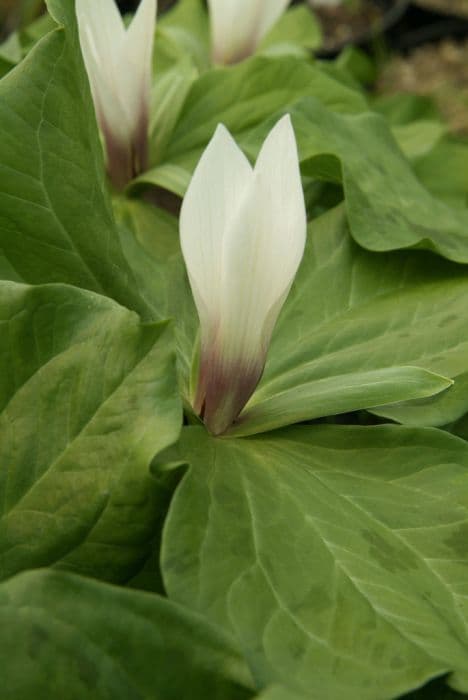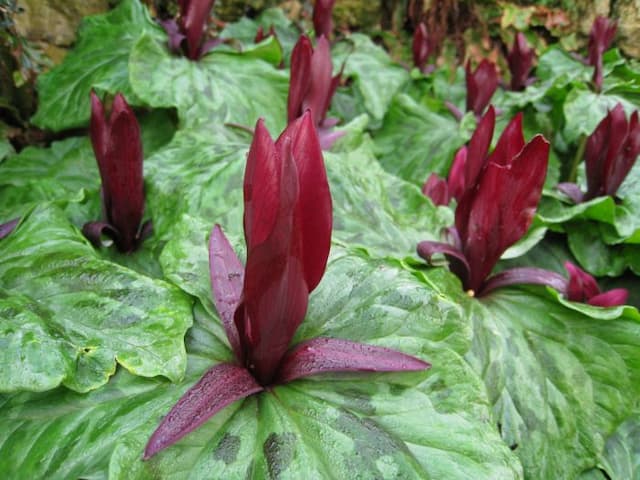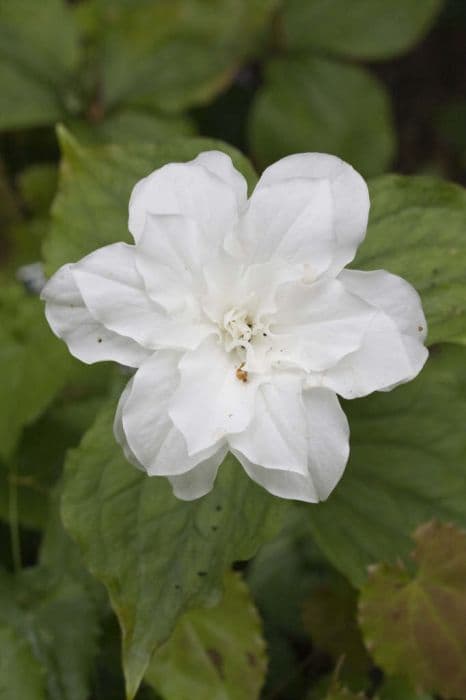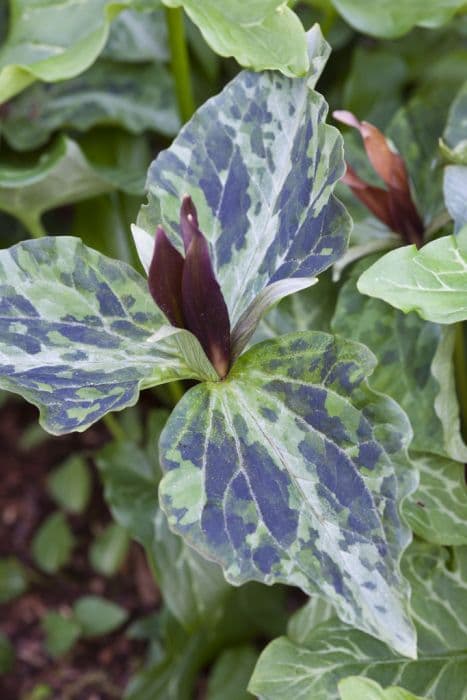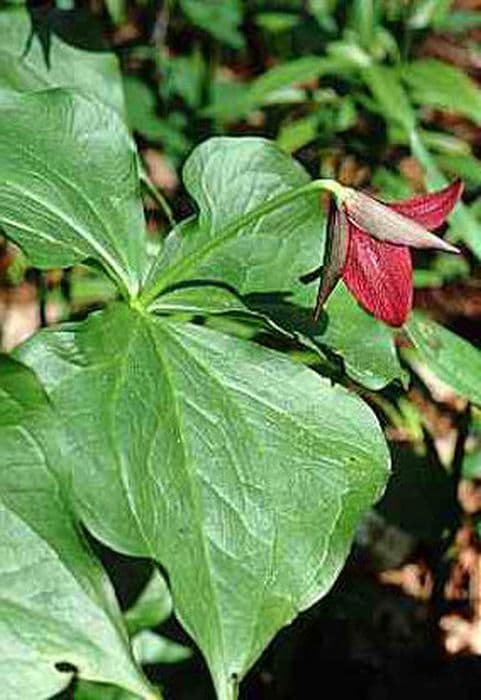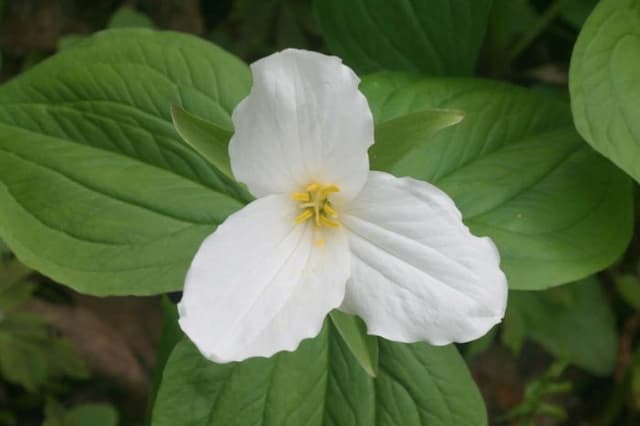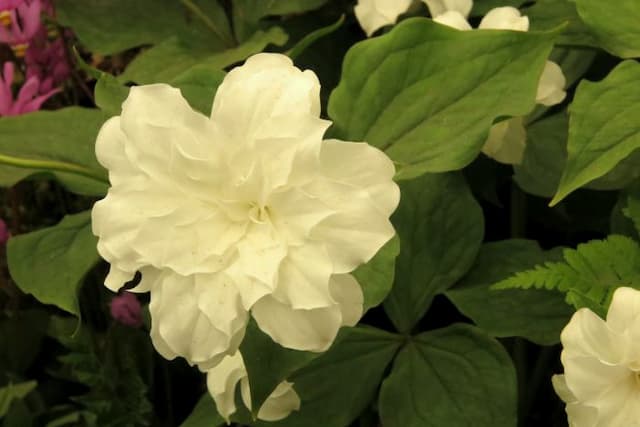White Camas Zigadenus elegans

ABOUT
The Zigadenus elegans, commonly known as the mountain deathcamas or elegant camas, is a perennial plant characterized by its distinctive appearance. It features a sturdy, vertical stem that is topped with a cluster of small, star-shaped flowers. The flowers are typically creamy white, marked with a greenish central vein that gives them a unique and eye-catching appeal. The leaves of the mountain deathcamas are mainly basal, meaning they primarily grow at the base of the plant. These leaves are long, narrow, and grass-like, with a smooth texture and a deep green color that accentuates the creaminess of the flowers above. The overall structure of the mountain deathcamas is elegant and somewhat stately, earning it the descriptor "elegans" in its name. The flower cluster forms a dense, rounded umbel, creating a spray of starry blooms that can add a touch of elegance to the landscape. The plant thrives in various environments, often found growing in meadows or grassy slopes, where it stands out among other vegetation due to its distinctive floral display. Despite being visually appealing, it's essential to note that every part of the mountain deathcamas is highly toxic if ingested. Its beauty should therefore be admired from a distance.
About this plant
 Names
NamesSynonyms
Mountain Death Camas, White Camas, Elegant Camas, Alkali Grass, Star Lily, Sand Lily
Common names
Anticlea elegans, Melanthium elegans, Zygadenus intermedius, Zigadenus intermedius.
 Toxicity
ToxicityTo humans
Mountain Deathcamas (Zigadenus elegans) is highly toxic to humans. Ingesting any part of this plant can lead to severe poisoning. Symptoms typically include nausea, vomiting, abdominal pain, weakness, dizziness, marked hypotension, bradycardia or tachycardia, respiratory depression, seizures, and possible cardiac arrhythmia. The toxins, especially zygacine and other steroidal alkaloids, can affect the nervous and cardiovascular systems. Severe poisoning can be fatal if not treated promptly.
To pets
Mountain Deathcamas is also toxic to pets. Ingestion of any part of this plant can result in severe poisoning. Symptoms in pets may include vomiting, salivation, lethargy, weakness, ataxia, tremors, seizures, and potentially life-threatening changes in heart rate and blood pressure. The steroidal alkaloids present in the plant can affect both the nervous and cardiovascular systems of the animal. Consumption of Mountain Deathcamas can be fatal for pets without timely veterinary intervention.
 Characteristics
CharacteristicsLife cycle
Perennials
Foliage type
Deciduous
Color of leaves
Green
Flower color
White
Height
2 feet [60 cm]
Spread
1 foot [30 cm]
Plant type
Herb
Hardiness zones
4
Native area
North America
Benefits
 General Benefits
General Benefits- Ornamental Value: Zigadenus elegans, commonly known as White Camas, has attractive star-shaped white flowers that add aesthetic appeal to gardens and landscapes.
- Wildlife Attraction: The blossoms of the White Camas are a food source for pollinators such as bees and butterflies, promoting biodiversity.
- Erosion Control: The fibrous root system of White Camas helps to stabilize soil and prevent erosion on slopes or in areas susceptible to soil loss.
- Drought-Tolerance: White Camas is well-adapted to survive in conditions with low water availability, making it suitable for xeriscaping and dry climates.
- Low Maintenance: Requiring minimal care once established, White Camas is an excellent choice for gardeners seeking low-maintenance landscaping options.
- Native Plant Conservation: As a native North American species, planting White Camas can support local ecosystems and help preserve regional flora.
 Medical Properties
Medical Properties- This plant is not used for medical purposes.
 Air-purifying Qualities
Air-purifying QualitiesThis plant is not specifically known for air purifying qualities.
 Other Uses
Other Uses- Zigadenus elegans, commonly known as Mountain Deathcamas, can be utilized as a natural dye source, providing shades of yellow or green depending on the mordant used.
- Insect repellent properties have been attributed to Mountain Deathcamas when its crushed leaves are applied to the skin, though this practice may be risky given the plant's toxic nature.
- The plant has been historically used as a marker of ecological health, indicating undisturbed soil and the presence of a rich diversity of plant species in an area.
- Gardeners may cultivate Mountain Deathcamas for its aesthetic appeal, with its starry white flowers adding beauty to naturalistic plantings and wildflower gardens.
- The plant's fibrous roots can be incorporated into weaving or basketry as binding material by communities practicing traditional crafts.
- Mountain Deathcamas serves as an educational tool in botany and horticulture to demonstrate characteristics of toxic plants and the importance of proper identification.
- The robust nature of Mountain Deathcamas can contribute to erosion control in areas prone to soil degradation, as its root system holds the soil together.
- Florists may use the dried stalks and flowers of Mountain Deathcamas for inclusion in everlasting floral arrangements, due to their long-lasting nature.
- Its presence on a property can alert pet owners to be vigilant, educating them about plant toxicity and the importance of monitoring animals while outdoors.
- Mountain Deathcamas seed pods can be collected and used for crafting purposes, such as additions to homemade potpourris or decorative displays.
Interesting Facts
 Feng Shui
Feng ShuiZigadenus elegans, commonly known as white camas, is not used in Feng Shui practice.
 Zodiac Sign Compitability
Zodiac Sign CompitabilityWhite camas is not used in astrology practice.
 Plant Symbolism
Plant Symbolism- Caution: Also known as "White Camas," Zigadenus elegans is a plant with toxic properties, symbolizing the need for caution and carefulness in our interactions and choices.
- Resilience: Able to grow in a variety of conditions, from open prairies to forest clearings, the White Camas represents the ability to endure and thrive in different environments.
- Purity: The plant's delicate white flowers can symbolize purity and innocence, perhaps reflecting the untouched and pristine nature of the landscapes it often inhabits.
- Deception: Because White Camas can be mistaken for the edible camas bulbs, it also represents the potential of deception or things not being what they seem on the surface.
- Balance: Balancing its delicate beauty with its toxic nature, Zigadenus elegans may symbolize the balance between vulnerability and strength.
 Water
WaterWhite Camas should be watered deeply but infrequently, allowing the soil to dry out slightly between watering sessions. Generally, provide the plant with about 1 inch of water per week, adjusting based on rainfall and temperature conditions. Over-watering can lead to bulb rot, so it's critical to ensure proper drainage. During the active growing season in spring and early summer, make sure to maintain consistent watering. In winter, when the plant is dormant, reduce watering significantly to prevent any potential for rot.
 Light
LightWhite Camas thrives best in full sun to partial shade. It should be situated in a spot that receives at least 6 hours of direct sunlight per day. If grown in too much shade, the plant may not flower as vigorously. The ideal location would provide morning sunlight and afternoon shade, especially in hotter climates to prevent scorching.
 Temperature
TemperatureWhite Camas is hardy and can tolerate a temperature range from about 60°F to 75°F as ideal growing conditions. It can survive minimum temperatures down to about -30°F, which makes it suitable for many different climates. It is important to avoid extremely hot temperatures, as this can stress the plant and lead to poor flower development.
 Pruning
PruningPruning White Camas is mostly limited to deadheading spent flowers to promote more blooms and prevent self-seeding if not desired. After flowering, you can cut back the flower stalks to the base. Pruning should be done annually, immediately after the blooming period has ended.
 Cleaning
CleaningAs needed
 Soil
SoilMountain deathcamas thrives in a well-draining, sandy or loamy soil with a pH ranging from slightly acidic to neutral, roughly between 5.5 and 7.0. A mix consisting of garden soil, sand, and peat or compost would be ideal to mimic its natural habitat and provide proper drainage and nutrients.
 Repotting
RepottingMountain deathcamas, being a perennial, does not require frequent repotting. It is generally advised to repot or divide the plant every 3-4 years to refresh the soil and to manage its spread in the garden.
 Humidity & Misting
Humidity & MistingMountain deathcamas fares best in moderate humidity conditions typical of outdoor environments. While it does not have specific humidity requirements, it is tolerant of a range of humidity levels found in most temperate climates.
 Suitable locations
Suitable locationsIndoor
Grow in well-draining soil, under bright, indirect light.
Outdoor
Plant in well-draining soil; full sun to partial shade.
Hardiness zone
4-9 USDA
 Life cycle
Life cycleZigadenus elegans, commonly known as White Camas, begins its life cycle as a seed, which, upon finding favorable ground and temperature conditions, germinates. The seedling grows into a bulb, which serves as an energy reserve and enables the plant to survive through winter. In spring, the bulb sends up linear leaves and a flowering stalk, which bears clusters of creamy white flowers that are star-shaped. After pollination, which is generally by insects, the flowers produce capsule-like fruits containing numerous seeds. These seeds are dispersed by various means such as wind or animals, and once they land in a suitable location, the cycle begins anew. The plant is perennial, so the bulb can continue to sprout new growth and flowers for several years before it expires.
 Propogation
PropogationPropogation time
Spring to early summer
For Zigadenus elegans, commonly known as the white camas, the most popular method of propagation is through seed. Seeds should be sown in fall to coincide with the natural cycle of the plant. The cold period of winter acts as a stratification period, which helps to break the seed dormancy, leading to spring germination. To propagate white camas by seed, sow them directly into the ground or into a seed starting mix at a depth roughly twice the size of the seed, which is typically less than 1/4 inch (approximately 6 millimeters) deep. Since white camas seeds are quite small, they should be lightly covered with soil and kept moist until germination occurs. It is important to ensure that the soil is well-drained to prevent the seeds from becoming waterlogged, which could cause them to rot before they have a chance to germinate.
